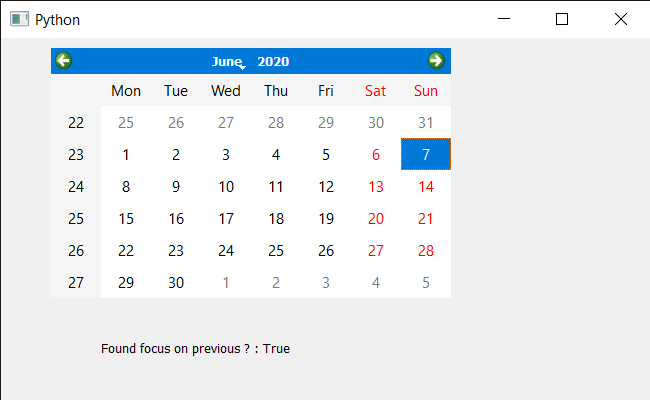En este artículo veremos cómo podemos hacer el foco al widget anterior de QCalendarWidget. Para hacer esto usamos el focusPreviousChildmétodo. Encuentra un nuevo widget para enfocar el teclado, según corresponda para Shift+Tab, y devuelve verdadero si puede encontrar un nuevo widget, o falso si no puede.
Para hacer esto, usaremos
focusPreviousChildel método con el objeto QCalendarWidget.Sintaxis: calendar.focusPreviousChild()
Argumento: no requiere argumento
Return : Devuelve bool
A continuación se muestra la implementación.
# importing libraries
from PyQt5.QtWidgets import *
from PyQt5 import QtCore, QtGui
from PyQt5.QtGui import *
from PyQt5.QtCore import *
import sys
class Window(QMainWindow):
def __init__(self):
super().__init__()
# setting title
self.setWindowTitle("Python ")
# setting geometry
self.setGeometry(100, 100, 650, 400)
# calling method
self.UiComponents()
# showing all the widgets
self.show()
# method for components
def UiComponents(self):
# creating a QCalendarWidget object
self.calender = QCalendarWidget(self)
# setting geometry to the calender
self.calender.setGeometry(50, 10, 400, 250)
# setting cursor
self.calender.setCursor(Qt.PointingHandCursor)
# creating label to show the properties
self.label = QLabel(self)
# setting geometry to the label
self.label.setGeometry(100, 280, 250, 60)
# making label multi line
self.label.setWordWrap(True)
# focus previous child
value = self.calender.focusPreviousChild()
# setting text to the label
self.label.setText("Found focus on previous ? : " + str(value))
# create pyqt5 app
App = QApplication(sys.argv)
# create the instance of our Window
window = Window()
# start the app
sys.exit(App.exec())
Producción :
Publicación traducida automáticamente
Artículo escrito por rakshitarora y traducido por Barcelona Geeks. The original can be accessed here. Licence: CCBY-SA